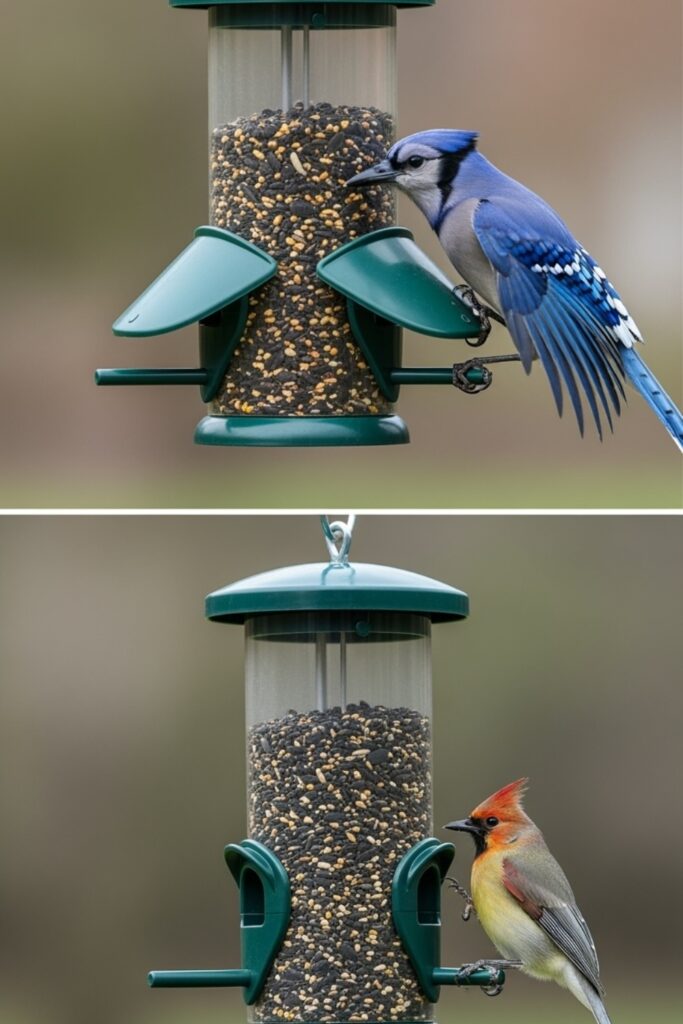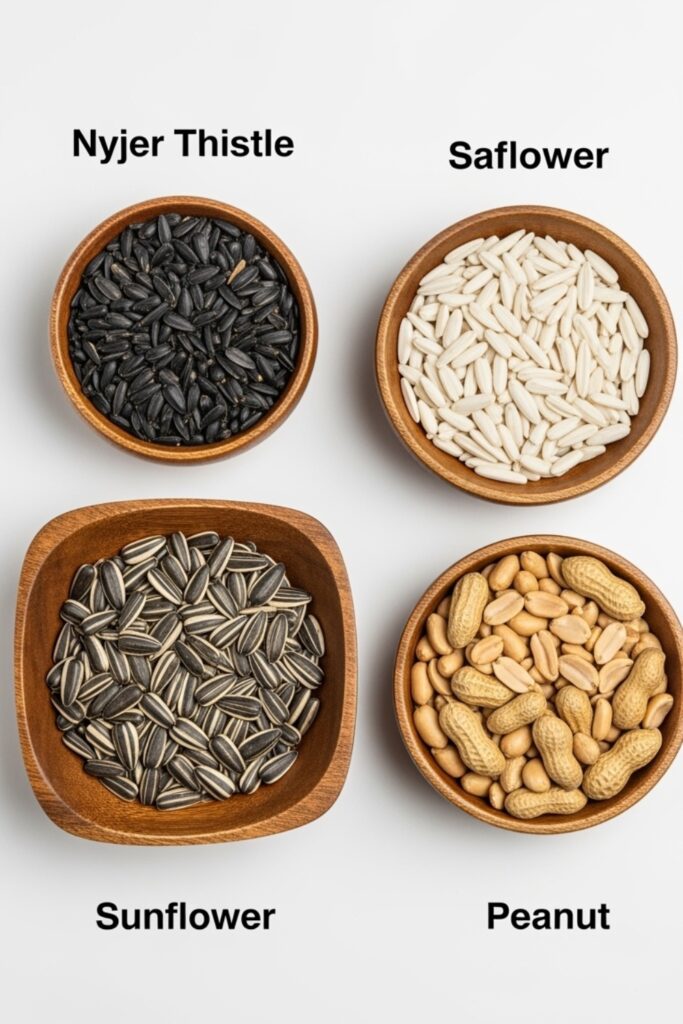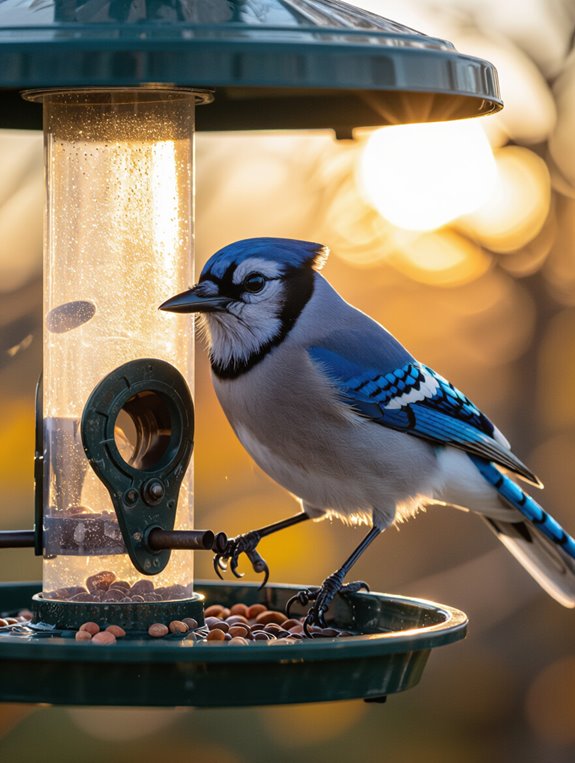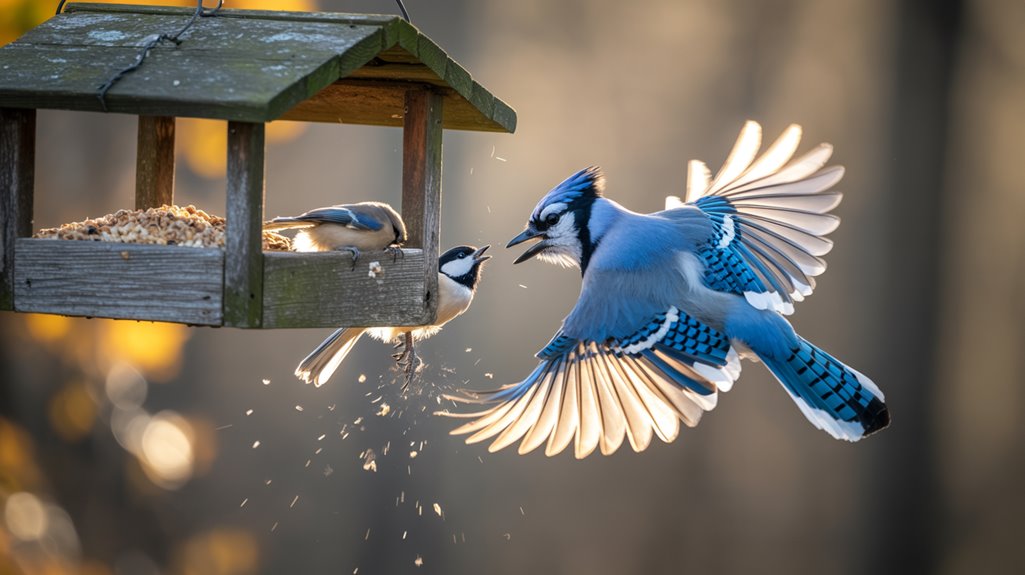You can effectively exclude blue jays from bird feeders by implementing caged tube feeders with restrictive perch dimensions and weighted mechanisms that respond to their superior body mass.
Target their selective feeding preferences by offering nyjer thistle and safflower seeds while avoiding sunflower seeds, peanuts, and cracked corn that trigger their resource monopolisation behaviours.
Strategic placement of a dedicated blue jay feeding station 20-30 feet away exploits their territorial feeding patterns and hierarchical dominance behaviours for ideal species management.
Key Takeaways
- Use caged tube feeders with wire mesh barriers that allow small birds through while excluding larger blue jays.
- Choose nyjer thistle and safflower seeds, which blue jays naturally avoid due to their feeding preferences.
- Install weight-activated feeders that close feeding ports when heavier birds like blue jays land on perches.
- Create a separate feeding station 20-30 feet away, stocked with peanuts and sunflower seeds to divert blue jays.
- Avoid seed mixes containing sunflower seeds, peanuts, and cracked corn that attract blue jays to feeders.
Understanding Blue Jay Behaviour and Aggression
When blue jays arrive at your feeder, they exhibit highly territorial behaviour that stems from their evolved survival strategies and complex social hierarchy. These corvids demonstrate resource monopolisation through aggressive displacement behaviours, effectively dominating feeding zones and excluding smaller passerines.
Their bad reputation among backyard birders is well-earned, as they’ll systematically empty feeders while utilising intimidation tactics against competitors. The aggressive blue jay’s behavioural repertoire includes threat displays, vocalisations, and physical confrontation to establish dominance hierarchies.
You’ll observe that jays can’t simply coexist peacefully because their innate territoriality compels them to control high-value food sources.
This dominance-driven behaviour reflects their intelligence and adaptability, as they’ve learned to exploit concentrated food resources that suburban environments provide, maximising caloric intake while minimising energy expenditure through strategic territorial control.

Why Blue Jays Dominate Bird Feeders
Blue jays achieve feeder dominance through a convergence of morphological adaptations and behavioural strategies that give them decisive advantages over competing avian species.
Their superior cognitive abilities enable rapid identification and systematic exploitation of food sources, while their robust beaks facilitate efficient seed extraction and consumption.
Their territorial aggression creates effective exclusion zones around bird feeders, forcing subordinate species to abandon prime feeding locations. You’ll observe these behavioural patterns consistently:
- Aggressive displacement behaviours: Direct confrontation with smaller birds
- Resource monopolisation tactics: Sustained occupation of feeding stations
- Rapid consumption rates: Complete depletion of feeder contents within hours
- Persistent foraging pressure: Continuous presence at established food sources.
This behavioural dominance stems from their bold temperament and enhanced foraging efficiency, establishing blue jays as apex competitors in backyard feeding hierarchies.
Use Caged Feeders to Exclude Large Birds
Several structural modifications to feeder architecture can effectively exploit the morphological limitations of blue jays while maintaining accessibility for smaller passerines.
Caged tube feeders with restrictive perch dimensions create selective barriers that prevent large corvids from accessing seed compartments.
Wire mesh cages surrounding standard feeders allow smaller birds to navigate through openings while physically excluding blue jays based on body size differentials.
Weighted perch mechanisms provide dynamic exclusion systems that automatically close feeding ports when heavier species attempt access.
These pressure-sensitive devices respond to blue jay body mass while remaining open for lightweight finches and chickadees. Use feeders with pole-mounted configurations combined with baffle systems to create additional physical impediments.
This multi-layered approach grants you complete control over species composition at feeding stations without restricting smaller birds’ foraging opportunities.
Choose Seeds That Blue Jays Avoid
Blue jays exhibit selective feeding behaviours that favour larger, high-energy seeds while demonstrating avoidance patterns toward specific seed types.
You can exploit these behavioural preferences by offering nyjer and safflower seeds, which blue jays consistently reject due to their size, taste, and nutritional profile.
Commercial seed mixes containing chiefly large seeds like sunflower and peanuts will attract blue jays, so you’ll need to avoid these formulations entirely.

Nyjer and Safflower Seeds
The selective feeding preferences of Corvidae family members create opportunities for targeted seed selection strategies. You can exploit blue jays’ aversion to specific seed types by implementing nyjer thistle and safflower selections.
These corvids demonstrate consistent avoidance behaviours toward smaller seed varieties, preferring larger, high-energy alternatives like sunflower seeds and peanuts.
Strategic seed deployment offers liberation from blue jay dominance:
- Nyjer thistle seeds: Small black seeds that blue jays consistently bypass due to size preferences
- Safflower seeds: Bitter-tasting seeds that trigger avoidance responses in blue jays
- Blended formulations: Mixing nyjer and safflower creates inhospitable feeding environments for aggressive corvids
- Behavioural modification: Consistent use reshapes feeding territory dynamics, favouring smaller songbirds.
This approach transforms your feeding station into a selective environment where desired species can access resources without corvid interference.
Avoid Large Seed Mixes
While targeted seed selection proves effective, complementary strategies involving seed mix composition amplify your success in corvid deterrence. You’ll want to eliminate commercial blends containing sunflower seeds, peanuts, and cracked corn; these high-energy components trigger aggressive foraging behaviours in “Cyanocitta cristata”.
Instead, select specialised formulations that emphasise smaller seed varieties, accommodating the morphological constraints of desirable passerines while discouraging jay exploitation.
Your feeding station’s species composition shifts dramatically when you remove large-seed attractants. Blue jays exhibit strong preferences for calorie-dense options, so eliminating these from your primary feeders redirects their attention elsewhere.
Focus on blends featuring nyjer, millet, and safflower seeds that support small birds’ nutritional requirements without appealing to corvid feeding patterns. This selective approach maintains your feeding freedom while creating an environment where finches, chickadees, and nuthatches can forage undisturbed.
Install Tube Feeders With Small Perches
Since Cyanocitta cristata exhibits distinct morphological constraints that limit feeding adaptability, you can exploit these behavioural limitations through strategic feeder selection.
Tube-style feeders with small perches positioned directly above seed holes create physical barriers that prevent blue jays from accessing food sources while maintaining unrestricted access for smaller passerines.
Strategic feeder modifications include:
- Perch positioning: Install perches immediately above seed holes to restrict large-bodied species
- Caged tube systems: Utilise protective barriers that selectively exclude larger birds
- Weighted mechanisms: Deploy feeders with closure systems activated by heavier species
- Species-specific targeting: Focus on finches, chickadees, and similar small birds.
These tube feeder configurations effectively leverage size-based exclusion principles, granting you complete control over which species access your feeding stations without compromising the feeding behaviour of desirable, smaller birds.
Create a Dedicated Blue Jay Feeding Station
Establishing a separate feeding station specifically for Cyanocitta cristata represents a diversionary strategy that exploits their territorial feeding patterns and hierarchical dominance behaviours. Position this alternative food source approximately 20-30 feet from your primary feeders to capitalise on their natural foraging range preferences.
Stock the station with whole peanuts, cracked corn, and sunflower seeds: high-energy foods that satisfy their omnivorous dietary requirements and metabolic demands.
You’ll observe that blue jays exhibit strong site fidelity once they’ve established a preferred feeding location. This behavioural tendency works in your favour, as they’ll typically defend their designated territory against conspecifics while leaving your main feeders undisturbed.
The diversionary approach respects their ecological role while granting you autonomy over your preferred feeding arrangements without resorting to exclusionary tactics.
Strategic Feeder Placement Around Your Yard

You’ll achieve ideal blue jay deterrence by implementing strategic spatial separation between feeding stations across your yard’s landscape.
Position blue jay-specific feeders at maximum distances from songbird feeders to exploit their territorial behaviour patterns and reduce competitive interference.
Avoid placing any feeders near high-traffic zones where blue jay activity increases, as this behavioural tendency encourages the establishment of feeding territories in undesirable locations.
Distance Between Feeders
Strategic spatial distribution of feeding stations greatly influences corvid behaviour and territorial dynamics in residential environments. You’ll achieve ideal blue jays far away results by implementing calculated distances between your feeding apparatus. This methodology disrupts their dominance patterns while preserving feeding opportunities for target species.
Effective distance protocols include:
- Minimum 30-foot separation between blue jay feeders and other bird feeding stations to reduce interspecies competition
- 15-foot intervals between general feeders to accommodate diverse avian species without territorial overlap
- Dense vegetation barriers positioned strategically to create visual and physical obstacles for corvid access
- Elevated mounting systems on shepherd’s hooks or overhead cables to limit blue jay accessibility.
This systematic approach allows you to maintain feeding autonomy while naturally discouraging blue jay monopolisation of your backyard bird sanctuary.
Dedicated Blue Jay Stations
Beyond spatial separation techniques, implementing dedicated corvid feeding stations represents a sophisticated behavioural management strategy that exploits blue jays’ territorial instincts and foraging preferences.
You’ll establish dominance hierarchies by positioning specialised feeders in secluded yard perimeters, effectively redirecting their aggressive foraging behaviours away from smaller songbird populations.
Stock these stations with high-energy provisions, including peanuts, acorns, and sunflower seeds: resources that satisfy their nutritional requirements while maintaining territorial boundaries. Install robust tray or ring feeders capable of withstanding their substantial body weight and vigorous feeding mechanics.
This diversionary approach allows you to maintain control over your feeding environment without restrictive exclusion methods.
Meanwhile, supplement your primary stations with safflower and nyjer thistle seeds, which blue jays naturally avoid, creating species-specific feeding zones that preserve your backyard’s ecological balance.
High Traffic Area Avoidance
While dedicated feeding stations address territorial redirection, ideal feeder placement within your yard’s topography requires careful analysis of blue jay movement patterns and spatial behavioural triggers. Strategic positioning away from high-traffic zones eliminates territorial establishment opportunities, preventing aggressive nest-building behaviours that compromise feeding accessibility for smaller species.
Deploy feeders using these spatial distribution principles:
- Perimeter positioning – Place blue jay-specific feeders along property boundaries, distancing them from central yard activities
- Isolation protocols – Maintain a minimum 15-foot separation between species-specific feeding stations to reduce interspecies competition
- Cover elimination – Position feeders away from trees, shrubs, or structures that enable ambush behaviours
- Traffic pattern analysis – Identify low-activity zones where jays around feeding stations won’t disrupt smaller birds’ foraging routines.
This approach grants you complete control over avian territorial dynamics while preserving feeding opportunities for desired species.
Weighted Perch Feeders That Close Under Heavy Birds

Because blue jays (Cyanocitta cristata) exhibit markedly higher body mass than most songbird species, weighted perch feeders utilise biomechanical triggers to selectively exclude these corvids from accessing seed ports.
When jays land, their increased weight activates the closing mechanism, preventing seed monopolisation and territorial dominance behaviours.
| Bird Species | Weight Range | Feeder Response |
|---|---|---|
| Blue Jay | 70-100g | Ports close |
| Cardinal | 33-65g | Ports remain open |
| Chickadee | 9-14g | Ports remain open |
This weight-sensitive technology operates through calibrated perch systems that detect mass differentials. The mechanism reopens automatically when heavier birds depart, restoring access for smaller species.
You can deploy these feeders via hanging or pole-mounting configurations. This approach provides effective corvid deterrence while maintaining feeding opportunities for desired songbird populations, supporting natural feeding hierarchies without complete exclusion.
Mix Different Feeder Types for Various Bird Species
Diversifying feeder configurations across your feeding station creates species-specific microhabitats that naturally segregate bluejays from smaller songbirds through behavioural partitioning. You’ll establish territorial boundaries through the strategic placement of complementary feeding mechanisms that exploit distinct foraging preferences.
Implement these targeted configurations:
- Tube feeders with small ports: Restrict access to finches and chickadees while excluding larger corvids
- Suet cages positioned vertically: Accommodate clinging species like nuthatches and woodpeckers
- Nyjer sock feeders: Attract goldfinches and siskins through specialised seed presentation
- Ground-level platform feeders: Satisfy ground-foraging species away from aerial feeding zones.
This multi-tiered approach redirects blue jay activity since jays love easily accessible, high-volume food sources. You’re creating ecological niches that naturally channel different species toward their preferred feeding methodologies, reducing competitive pressure at individual stations.
Benefits of Keeping Blue Jays in Your Backyard
Several compelling ecological advantages emerge when you maintain blue jay populations within your backyard ecosystem rather than implementing complete exclusion strategies. These corvids demonstrate sophisticated behavioural patterns that benefit your entire habitat.
You’ll observe their predatory consumption of caterpillars, snails, slugs, grasshoppers, beetles, and spiders, providing natural pest control mechanisms. Their alarm-calling behaviour functions as an early warning system, alerting resident species to approaching hawks and eagles through distinctive vocalisations.
I’m sure you’ll notice their protective territoriality as they chase off competing squirrels, chipmunks, and cats that threaten smaller passerines. Blue jays exhibit remarkable cognitive abilities, ranking among the most intelligent backyard species.
Their presence creates a dynamic surveillance network that enhances overall ecosystem security while maintaining a natural predator-prey balance.
Final Thought
You’ll achieve ideal feeder management by implementing species-selective exclusion strategies that exploit blue jays’ morphological limitations and behavioural patterns.
Through the systematic deployment of caged feeders, weighted perch mechanisms, and seed preference differentiation, you’re creating environmental pressures that redirect corvid foraging behaviours while maintaining ecosystem balance.
These evidence-based deterrent methodologies don’t eliminate blue jays but establish controlled feeding zones that accommodate diverse avian species’ specific dietary requirements and territorial behaviours within your backyard habitat.
